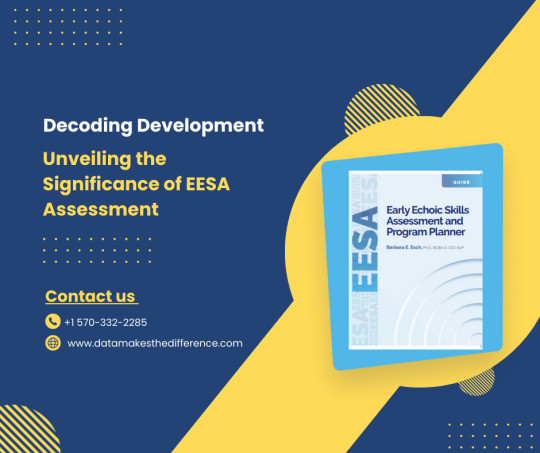#EmpoweringASD
Text
Decoding Development: Unveiling the Significance of EESA Assessment
In the ever-evolving landscape of autism intervention, understanding and addressing the unique communication challenges faced by individuals with autism spectrum disorder (ASD) is of paramount importance. One instrumental tool in this endeavor is the Early Echoic Skills Assessment (EESA). This article aims to decode the significance of the EESA assessment, shedding light on its role in unraveling the intricacies of early vocal imitation skills and fostering development in individuals with ASD.

Understanding the Foundation: Early Vocal Imitation Skills
Before delving into the significance of EESA, it's crucial to recognize the foundational role of early vocal imitation skills in language development. For individuals with ASD, who may face challenges in social communication, developing the ability to vocally imitate sounds, words, and phrases is a critical milestone. Early vocal imitation lays the groundwork for expressive language, social interaction, and overall communication proficiency.
EESA Assessment: A Comprehensive Approach
The EESA assessment is specifically designed to evaluate and enhance early vocal imitation skills in individuals with ASD. Developed within the framework of applied behavior analysis (ABA), EESA goes beyond traditional assessments by providing a comprehensive and systematic approach to understanding an individual's current abilities and challenges in the realm of vocal imitation.
1. Identifying Developmental Milestones:
The EESA assessment breaks down the complex process of vocal imitation into distinct developmental milestones. By categorizing these milestones, ranging from basic vocalization to more advanced imitation of words and phrases, the assessment provides a roadmap for understanding where an individual lies on the spectrum of vocal imitation skills.
2. Tailoring Interventions to Individual Needs:
One of the key advantages of the EESA assessment is its ability to inform personalized interventions. By identifying specific strengths and areas that may need additional support, caregivers, educators, and therapists can tailor interventions to suit the unique needs of each individual. This tailored approach increases the likelihood of success in fostering early vocal imitation skills.
3. Tracking Progress Over Time:
Progress in communication development is not always linear, and the EESA assessment recognizes this by providing a tool for tracking changes and improvements over time. Regular assessments allow for the measurement of progress, adjustment of interventions, and celebration of achievements, fostering a dynamic and responsive approach to individual needs.
Significance of EESA in Early Intervention:
1. Early Identification of Communication Barriers:
EESA plays a pivotal role in early identification of communication barriers. By pinpointing specific challenges in vocal imitation, such as difficulties in echoing sounds or imitating words, the assessment equips caregivers and educators with valuable insights. Early identification sets the stage for targeted interventions, addressing communication barriers before they become entrenched.
2. Foundation for Language Development:
Language development is a multifaceted process, and early vocal imitation skills form a crucial foundation. EESA, by assessing and enhancing these skills, contributes to the scaffolding necessary for the development of expressive language. This, in turn, opens pathways for improved social communication and interaction.
3. Individualized Support Strategies:
Each individual with ASD is unique, and the significance of EESA lies in its ability to inform individualized support strategies. Whether it's providing additional prompts, incorporating visual supports, or adapting the environment to encourage vocalization, EESA empowers caregivers and educators to implement targeted strategies tailored to the specific needs of each individual.
Challenges and Considerations:
While recognizing the significance of EESA, it's essential to acknowledge potential challenges and considerations in its implementation. Factors such as individual variability, environmental influences, and the need for ongoing assessment highlight the dynamic nature of communication development. EESA is not a one-size-fits-all solution but rather a dynamic tool that requires continuous evaluation and adaptation.
Conclusion: Empowering Development Through EESA Assessment
In conclusion, the significance of the EESA assessment lies in its capacity to decode the complexities of early vocal imitation skills in individuals with ASD. By identifying developmental milestones, tailoring interventions, and tracking progress over time, EESA becomes a powerful ally in the journey of early intervention. It empowers caregivers, educators, and professionals to navigate the intricate path of communication development, unlocking the potential for meaningful progress and enhanced quality of life for individuals with ASD.
Decoding development through EESA is not just a process; it is an ongoing commitment to understanding, supporting, and celebrating the unique journey of each individual. As we unveil the significance of the EESA assessment, we pave the way for a future where communication barriers are dismantled, and the echoes of progress resound through the lives of those with autism, fostering connection, understanding, and the realization of their full potential.
#EESAassessment#AutismCommunication#EarlyIntervention#SpeechDevelopment#ASDsupport#CommunicationMilestones#SpecialEducation#DecodingDevelopment#EmpoweringASD#UniqueVoices
1 note
·
View note